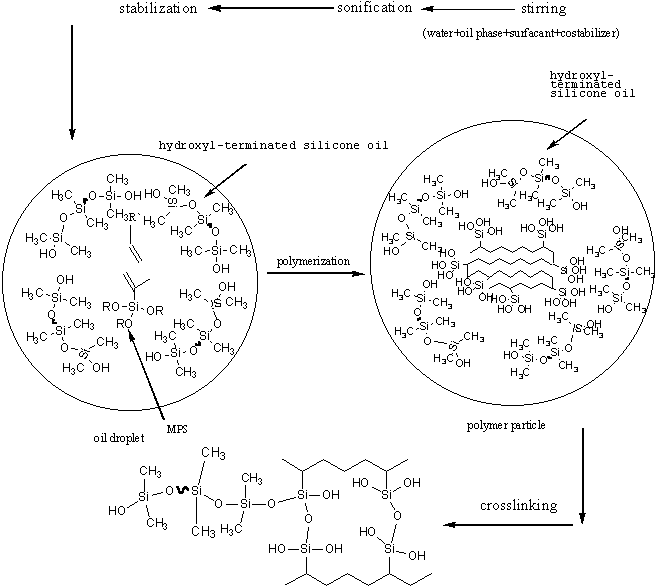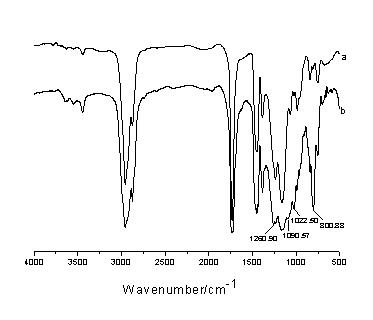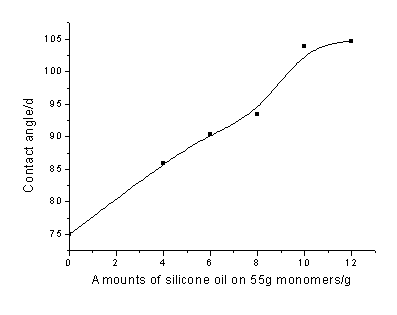http://www.chemistrymag.org/cji/2005/07c084ne.htm |
Dec. 16, 2005 Vol.7 No.12 P.84 Copyright |
Hydroxyl terminated silicone oil as co-stabilizer for miniemulsion copolymerization of acrylate and methacryloxy(propyl)-trimethoxysilane
Zhu Yangrong, Yang Huan, Zhang Jide, Yang Mujie(Department of Polymer Science and Engineering, Zhejiang University, Hangzhou 310027) Received on Oct. 12, 2005. Abstract Hydroxyl terminated silicone oil was successfully used as the co-stabilizer in the miniemulsion copplymerization of acrylate and methacryloxy(propyl) trimethoxysilane(MPS) in order to protect the silane moieties from hydrolysis and premature cross-linking by reducing their contact with water. Effects of the amounts of the silicone oil and MPS on the properties of the latex film prepared have been investigated. It was found that the contact angle of the latex film increases with increasing of the amount of the silicone oil, and the gel content and tensile strength of latex film were improved with an increase in the amount of the MPS incorporated into acrylate. The mechanism of silane incorporation in the presence of silicone oil through a miniemulsion approach is described and discussed.
Keywords co-stabilizer, miniemulsion, hydroxyl terminated silicone oil, methacryloxy(propyl) trimethoxysilane 1 INTRODUCTION
In recent years, there has been a growth of interest in co-stabilizer of miniemulsion polymerization and self-cross-linking polymer, because they have wide applications in the field of coating and adhesive. Moreover with the growing interest in miniemulsion polymerization, more and more sorts of co-stabilizer were reported. Such as poly(vinyl alcohol), poly(vinyl acetate)[1], carboxylate polyurethane[2] and vinyl siloxane rubber[3]. Simultaneously considerable efforts have been devoted to study the self-cross-linking polymer. In general, self-cross-linking polymer chains bear the reactive groups(such as epoxy groups[4], N-(isobutoxymethyl)-acrylamide[5], acetoacetate groups[6], ketone carbonyl groups[7] and alkoxysilanes[8]) which can make cross-linking reaction facilely, and so enhances the physical and chemical integrity of coalesced latex films. Latex film formation is a complicated and multistage process which is one of important factors for obtaining good mechanical property of film. The presence of a post-application cross-linking mechanism in aqueous coating composition offer major advantages with regard to the quality and the ultimate properties of the dried film. In this paper the incorporation of a post-application cross-linking mechanism into room temperature curing acrylic paints was achieved by adding alkoxysilanes to miniemulsion polymerization in the presence of hydroxyl terminated silicone oil as co-stabilizer.
The objective of this paper is to apply a batch miniemulsion polymerization technique to incorporate amounts of methacryloxy(propyl) trimethoxysilane(MPS) moieties into film-forming acrylate latex systems in the presence of hydroxyl terminated silicone oil as co-stabilizer. Silicone oil are generally difficult to be wetted and most materials adhere poorly to them. Therefore incorporating hydroxyl terminated silicone oil into this system as co-stabilizer, not only could prepare stable miniemulsion droplet, but also could improve the water and staining resistant of the coating film. The miniemulsion approach was deemed to be most appropriate for obtaining stable latexes, which can make silane groups incorporated into the copolymer structure, and allowing subsequent formation of cross-linked films. Although the hydrolysis and condensation reaction will still occur, the particles will remain colloidally stable due to the use of a surfactant/co-stabilizer stabilization system (Figure 1). The silane moiety will be protected from the aqueous phase by the "waterproof" oil droplet. The formation of a miniemulsion also requires a large amount of mechanical shear and ultrasonic to obtain stable miniemulsion droplets dispersed in the aqueous phase.

Figure 1 Mechanism of silane incorporation in the presence of silicone oil through a miniemulsion approach
2 EXPERIMENT SECTION
A typical recipe of miniemulsion is as follows: deionized water , 117g; MMA, 28g; BA,
19g; EHA, 3g; MPS, 5g; Hydroxyl Terminated Silicone Oil, 4g; SDS, 1g, NaHCO3,
0.15g; APS, 0.175g. Miniemulsion were prepared by dissolving the co-stabilizer (silicone
oil) in the monomer mixture. The oil phase was then added to aqueous SDS solution and
mixed for 10min with a magnetic stirrer at high speed. The mixture was then sonified for
10 min at 60% of output in pulse mode (CPS-2, Shanghai Branson Ultrasonic CO. China).
Immediately after sonication the resultant miniemulsion was transferred into a 500mL three
neck flask equipped with a mechanic stirrer and reflux condenser. Sodium bicarbonate was
used as a buffer in order to minimize the alkoxysilane hydrolysis reaction. APS (dissolved
in 10mL of deionized water) was added immediately after the temperature in the flask
reached 65ºC. Then the temperature increased to 75
In this study, the degree of cross-linking of the latex film was characterized by measuring film gel content (wt%). Contact angle and tensile strength measurements were used as indicators of the water resistance and the cohesive strength of the film.
The droplet size of the miniemulsion prepared had a narrow distribution and the droplet size was ~80nm. After placed 7 days the droplet size of the miniemulsion maintained at -90nm. The results indicated that the oil droplets were stable in the presence of hydroxyl terminated silicone oil as co-stabilizer.
Incorporation of alkoxysilanes into Latex systems using silicone oil as co-stabilizer were confirmed by FT-IR analysis. Figure 2 (b) depicts the FT-IR spectrum of the poly-acrylate incorporated with alkoxysilane in the presence of silicone oil after n-hexane extraction, (a) depicts the FT-IR spectrum of the pure polyacrylate. As a comparsion , the interesting peaks are 800©M-1 and 1261©M-1 which are attributed to vibration of carbon silicone bond in the Si(CH3)2 group of silicone oil chain and carbon silicone bond of alkoxysilanes, and 1016cm-1 attributed to vibration of Si-O. These mean that MPS did incorporate into the copolymer and silicon oil did graft into poly-acrylate chain by condensation of Si-OH of silicone oil and Si-OH of copolymer chains.

Figure 2 FT-IR spectra of latex films:(a) pure polyacrylate; (b) MPS/acrylate copolymer(synthesized by miniemulsion in the presence of silicone oil as co-stabilizer) after n-hexane extraction
The effect of the amount of silicone oil on the contact angle of the latex film is shown in Figure 3. It is seen that the contact angle of latex film increases with the increasing amount of silicone oil. It indicated that the water resistance of the film was improved by incorporating silicone oil into poly-acrylate.

Figure 3 Contact angle of latex film as function of amounts of silicone oil The gel content(wt%), tensile strength, pencil hardness and adhesion of latex film as function of the concentration of MPS in feed of monomers(wt%) is shown in Table 1. It is seen that the gel content and pencil hardness of latex film initially increase quickly with the increasing of concentration of MPS. The adhesion of the latex film is good.The gel content of latex film is more than 90%, especially reaches to 98% when the concentration of MPS is 12.5%. It indicated cross-linking reaction of the Si-OH in copolymer chains processed completely and silicone oil had been grafted on copolymer chain. The tensile strength of the latex film always increases when the concentration of the MPS increases. Table 1 Effect of the amounts of MPS on the gel content and tensile strength of the latex film
Latex film |
MPS/monomers(wt.%) |
Gel content (%) |
Adhesion |
Pencil hardness |
Tensile strength/MPa |
1 |
0 |
50.15 |
0 |
F |
1.57 |
2 |
2.5 |
90.00 |
0 |
HB |
2.58 |
3 |
5 |
93.50 |
0 |
HB |
3.05 |
4 |
7.5 |
95.15 |
0 |
H |
3.634 |
5 |
10 |
97.24 |
0 |
H |
9.11 |
6 |
12.5 |
98.48 |
0 |
H-2H |
13.50 |
4 CONCLUSION
In conclusion, incorporating MPS into latex system and using silicone oil as
co-stabilizer which grafting on copolymer chains could improve the water and staining
resistance of film and obtain good film-forming properties.
REFERENCES
[1] Aizpurua I, Amalvy J.I, Colloids Surf. A. Phys. Eng. Asp. 2000, 166: 59.
[2]Yu Z Q, Lee D Y, Cheong I W, J. Appl. Polym. Sci. 2003, 87: 1933.
[3]Zhang Q Y, Pei H N, Colloids Surf. A: Phys. Eng. Asp. 2004, 242: 9.
[4]Mouaziz H, Larsson A, Sherrington D C, Macromolecules, 2004, 37: 1319.
[5]Liu R H, Winnik M A . Macromolecules. 2001, 34: 7306.
[6]Esser R J, Devona J E, Setzke D E. Prog. Org. Coat. 1999, 36: 45.
[7]Nakayama Y. Prog. Org. Coat. 1997, 31: 105.
[8]Ioan M, Eric S D, Victoria L D. Macromolecules, 2003, 36: 328.
¡¡